Better Filtration for Your Heat Pump Water Heater
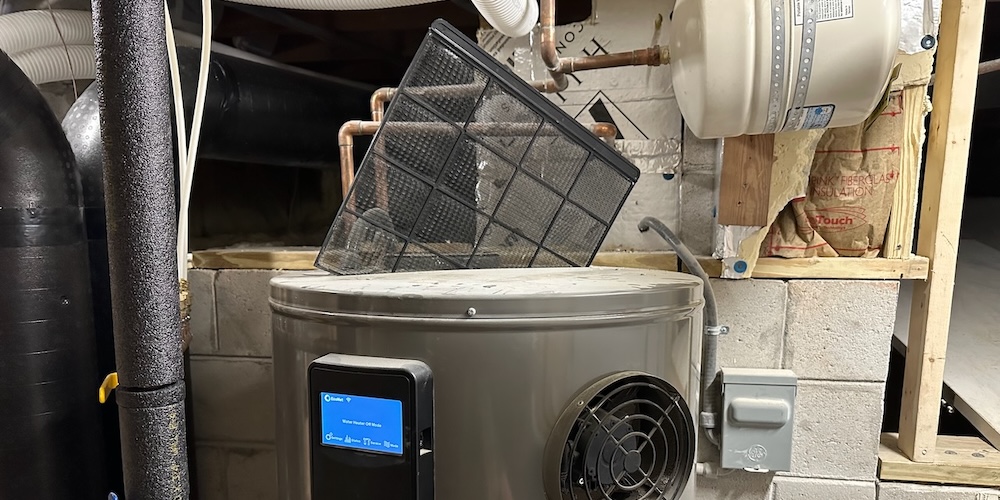
Surprise! Your heat pump water heater has a filter that needs to be cleaned. But you probably already knew that if you’re reading the Energy Vanguard Blog. It’s a thin little filter whose primary job is to keep larger particles from getting into the heat pump guts of your water heater. It will do a sort-of OK job at keeping the heat pump coil clean, but it’s not great. And worse, the filter doesn’t fit tightly in the slot, so some air will bypass the filter. So let’s talk about heat pump water heater filtration today.
The standard heat pump water heater filter
Gary Klein, one of the most knowledgeable people in the world on the topic of hot water, recently came to Atlanta and stayed at my house. I took the opportunity to shoot some some video with him, and here’s part one of the two videos we made on the topic of this article. Take a look.
Yeah, it’s embarrassing to ‘fess up to having such a dirty filter. But it’s been hard to keep up with it during our year-long basement renovation. Actually, that’s a lie. It’s not that hard to clean the filter, and I’ve been surprised how clean it has stayed during much of the work. The reason it was so dirty here is that we’d recently had drywall installed, and that’s quite a dusty process.
A serious filter upgrade
Now, let’s get to that better way of filtering the air in a heat pump water heater. My friend Ben Knopp in Virginia has installed the only external filter on a heat pump water heater that I know of. The video below discusses the issues and shows what Ben did.
Voilà! There you have it. The photo below shows the water heater behind that opening in the back of this closet and the MERV-13 attached to it.
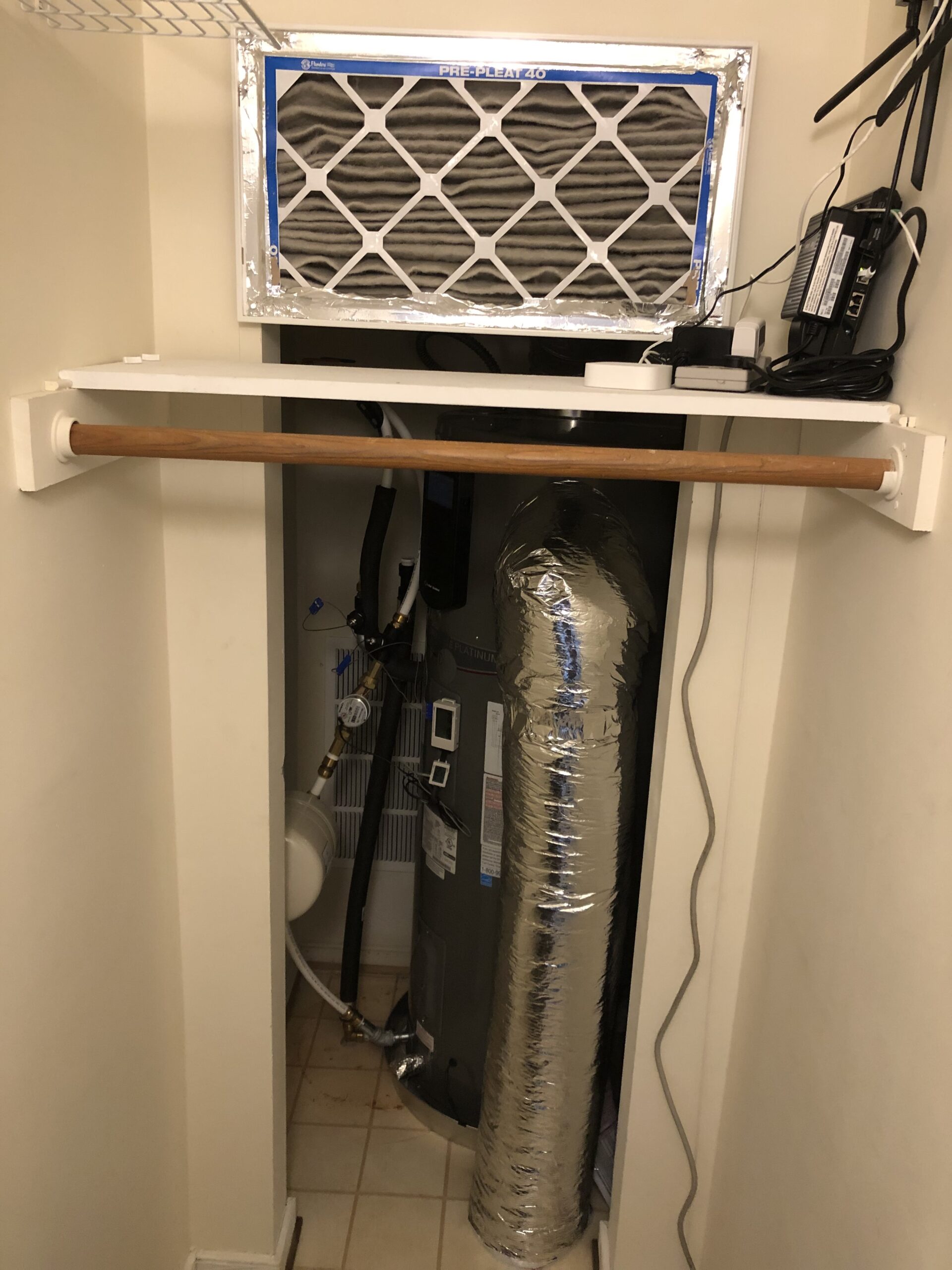
Yeah, the filter had collected quite a bit of dust at that point, but there was no significant effect on air flow. And now you’re wondering what were the air flow rates, right?
Before and after air flow rates
Ben and I gave a little presentation together at the ACEEE Hot Water Forum in 2022, and Ben provided the air flow rates he had measured. First, here’s what it was in the clean stock filter.
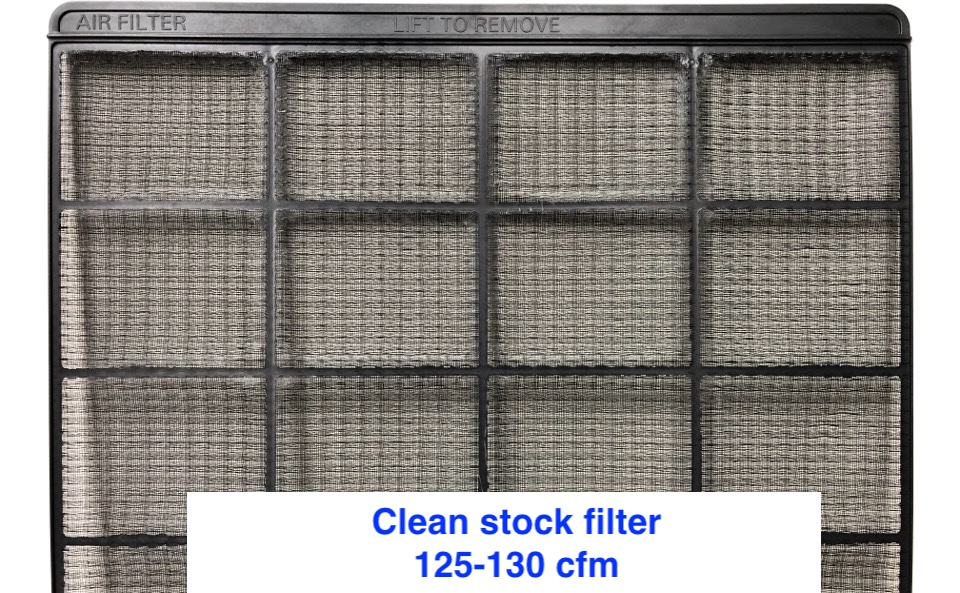
Then he threw away the stock filter and did his retrofit. Because of the little bit of duct work and the more resistive filter, the air flow rate decreased…but only to 121 cubic feet per minute (cfm), or 3 to 7 percent. In terms of pressure drop across the clean MERV-13 filter, he measured 0.049 inch of water column (iwc).
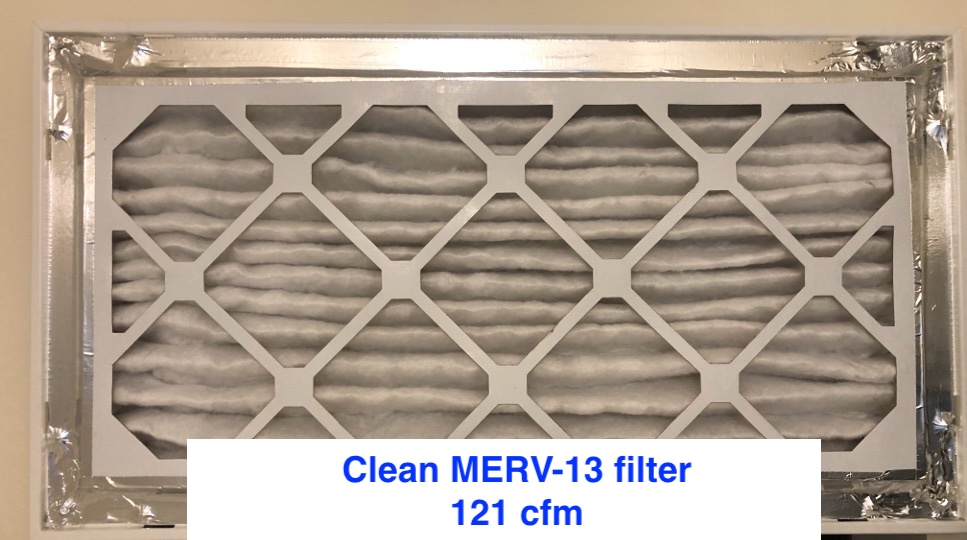
After more than three years of use, he took the photo below and again measured air flow and pressure drop. This time there was hardly any change in either. The air flow dropped from 121 cfm to119 cfm. The pressure drop went from 0.049 iwc to 0.051 iwc.
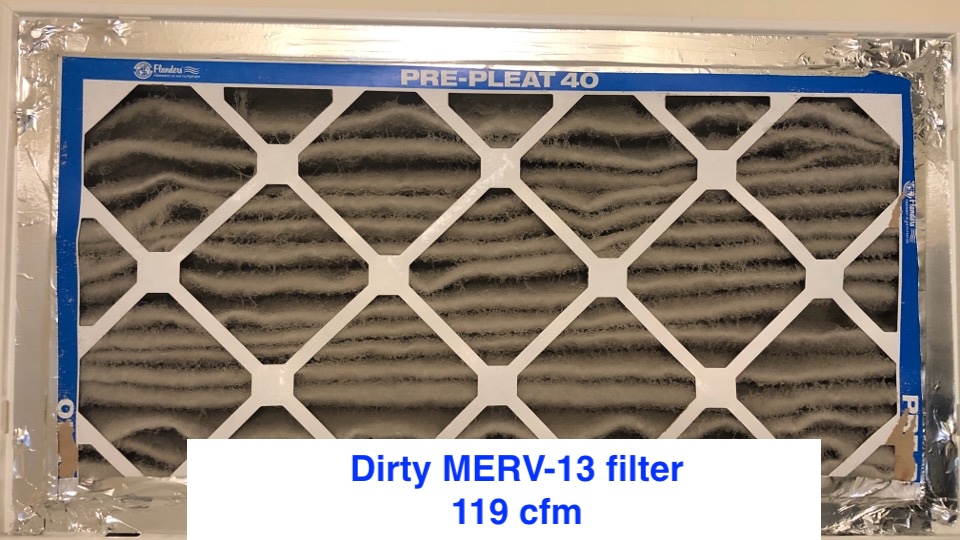
His first MERV-13 filter was sized at 12 inches high by 24 inches wide by 2 inches deep. Then he went a step further and installed a MERV-13 filter with the same height and width but double the depth at 4 inches. He calls his first one a 5 year filter. He says the 4 inch filter is a “lifetime” filter.
How to retrofit for an external MERV-13 filter
If you want to upgrade the filtration of your heat pump water heater, you need to be able to add ducts to it. The Rheem generation 4 that both Ben and I have came with takeoffs that make it easy to connect ducts. You can see the takeoff on the exhaust side of the heat pump in the lead photo at the top of this article.
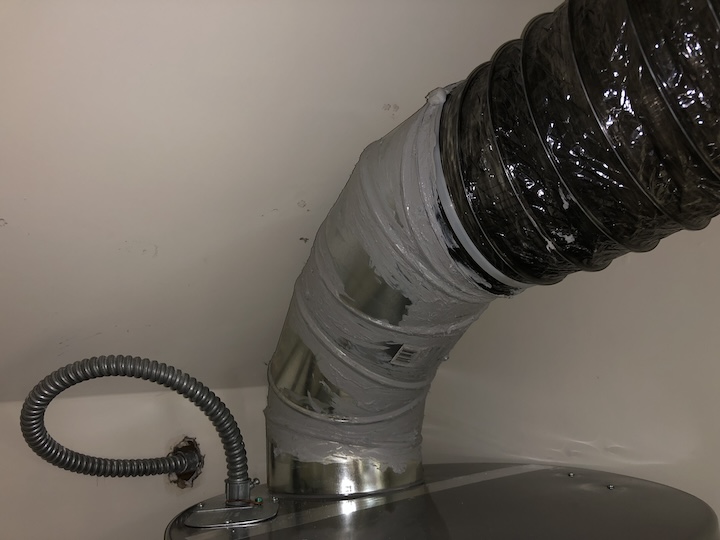
Above you can see Ben’s intake duct connected to the takeoff. He used two 45 degree elbows and a piece of flex duct to get over to the filter box shown below.
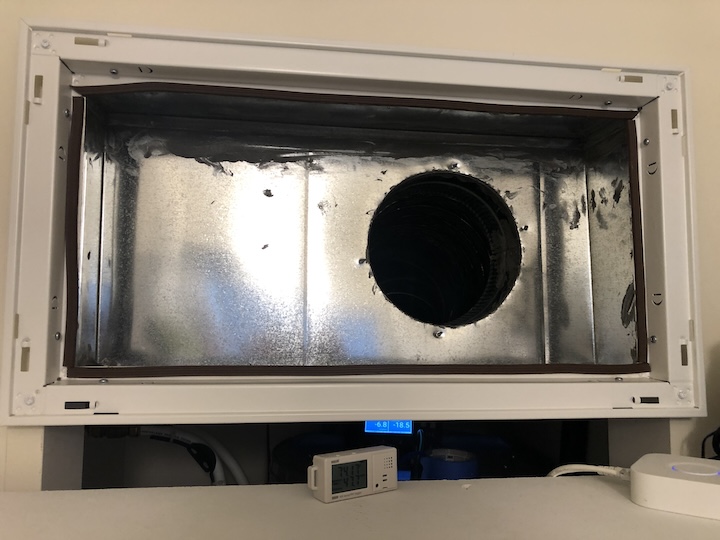
Then he popped a 12x24x2 inch MERV-13 filter in there and let ‘er rip. Since it was in a closet, he didn’t bother with the grille, but you could put this in a more public area with the grille on it.
And then there’s one last, important step. Be sure to remove the stock filter and seal the slot. You can use a foil-faced duct to do that. Clean the metal surface first, though. If you don’t seal that slot, you’ll get air sneaking in behind your nice, new high-efficiency filter, defeating the purpose of making the change.
Easy peasey, right?
The benefits of better filtration
I mentioned above that going with better filtration keeps the coil clean, but let’s list the benefits here:
- Keeps coil, blower, and other internal parts clean
- Reduces maintenance from regular stock filter cleaning to changing the MERV-13 filter once in several years or longer
- Improves your indoor air quality by removing more particulate matter
On that last benefit, Ben makes an excellent point. “I like to take advantage of any appliance that moves air to do better filtration and improve my indoor air quality, too.”
Do you have a heat pump water heater? Have you checked the filter? Have you done a filter upgrade like this?
Allison A. Bailes III, PhD is a speaker, writer, building science consultant, and the founder of Energy Vanguard in Decatur, Georgia. He has a doctorate in physics and is the author of a bestselling book on building science. He also writes the Energy Vanguard Blog. For more updates, you can follow Allison on LinkedIn and subscribe to Energy Vanguard’s weekly newsletter and YouTube channel.
Related Articles
Living With a Heat Pump Water Heater
3 Ways to Get Cleaner Indoor Air With Filtration
The Plug-in Heat Pump Water Heater Is Here!
Comments are welcome and moderated. Your comment will appear below after approval. To control spam, we close comments after one year.

Thank you once again for a sharing a great idea to extend the functioning and life of a Heat Pump Water Heater. Can you provide some tips on how to construct an inexpensive air filter box? An internet search provides some options to purchase an one, but spending $150 seems excessive for this use. Thank you.
Dale: If it’s going to be in a place where looks don’t matter, you can make your own out of sheet metal and just leave the filter exposed. That will save you the cost of a filter grille. You just need to make the box so it can hold the filter securely.
Dale, any HVAC tech you know should be able to make up a box with some panning and s-locks. Tape the seams with foil tape and you would be all set.
Was the pressure drop measured for a dirty original filter? How long had it been in use?
What is the minimal recommended CFM through the heat pump?
Robert: No, Ben said he never measured the pressure drop of the stock filter. I don’t think he ever really used it, so it never got dirty. Not sure about the minimum air flow needed.
Allison, sheetrock dust can be nasty, and the very fine variety got through that stock filter like it wasn’t there.
For the other parts of our lives when we don’t have sheetrock work in the space shared with a heat pump water heater, I’d want to keep that air flow as optimal as possible and a 7% drop seems a bit much for this very small heat pump. If the space shared with the heat pump water heater is mostly finished and reasonably clean, maybe sticking with the stock filter is the simplest and most efficient solution?
I’ve had my heat pump water heater (almost the same model as yours, I think) for about 5 years now, and maybe it’s time to take a peek under the hood. Occasional stock filter checks have never revealed much of any clogging.
Paul: Yeah, that’s one reason why all that dust is on the fan and the exhaust takeoff. Before our remodel started, I never saw much dirt on my stock filter either, but that doesn’t mean no dirt was around. I think some of it bypassed the filter.
“My friend Ben Knopp in Virginia has installed the only external filter on a heat pump water heater that I know of.” Well Allison, let my Rheem Gen 4 be the 2nd one you know of. Of course, I worked with Ben for several years, so it’s really just part of the central Virginia hub of filtered HPWHs. We have a handful of clients in central VA that we designed filtered HPWH installs for… I’m curious how many of them are changing their filters. Fortunately from Ben’s data, it looks like performance should be minimally impacted even with irregular filter changes.
Tray: Thanks for that info. It’s not really a surprise. When I was looking at the stuff I have about heat pump water heaters for this article, I looked at the presentation you and Ben gave at the 2019 PhiusCon. That’s where I first heard about and saw photos of Ben’s setup.
Ultimately it is up to manufacturers of HPWH, mini,splits, ducted splits, and so on to engineer good filtering with easily replaceable, house type filters. Not hard to do. Those thin screens on the Rheem pictured are totally ineffective for protecting the device much less inhabitants.
Does anyone have information about the relative value of ducting to the exterior? My new Aerotherm water heater has an option kit you can buy, but I was worried that between the added energy used to heat water from colder outside air and the energy loss of having another hole in the wall it’s counter-productive. Feeling all of that cold air coming from the unit without a ducting kit has me reconsidering.
Steve: It’s generally not recommended to duct a heat pump water heater to the outside. In addition to the problems you mention, you’ll create a pressure imbalance in the house if you duct only one side to the outdoors. That pressure difference will drive more air leakage.
Rather than ducting that cold air to outdoors, you can duct to another part of the house or maybe into the supply plenum of your air handler, if it’s close enough.
I will have to do something like this when we switch out to a heatpump WH. Ours is in the garage and our soil is very sandy and silty so there is allot of airborne dust much of the year. Looks like the dust bowl when you mow the weeds or mulch the oak leaves.
I’m not worried too much about the pressure drop over that filter as the detriment from the filter will be less impact than the gunk in the stock filter and the dust covering the coils.
At first with all new it might show a difference but compared to a unit without the filter 6 months later the retrofitted filter one will be flowing more air and have less reduction to heat transfer from dirt on coils.
I used to tape filters over the intake of the 2 ton window unit in the shop. Worked great.
I always thought about sticking one of those 2′ long dust collection canister filters on top of mine.
Great idea to add a real efficient filter for longer life. I didn’t see any mention of sealing the old filter slot when using an external filter. I’m sure some foil tape would work well. Be curious if you make a video of cleaning the fan and coil in the future?
Eric: Thanks for bringing that up. I think I must have assumed it would be obvious when I wrote the article, but there are always people who may miss that important detail. I just added a paragraph to the end of the how to section above.